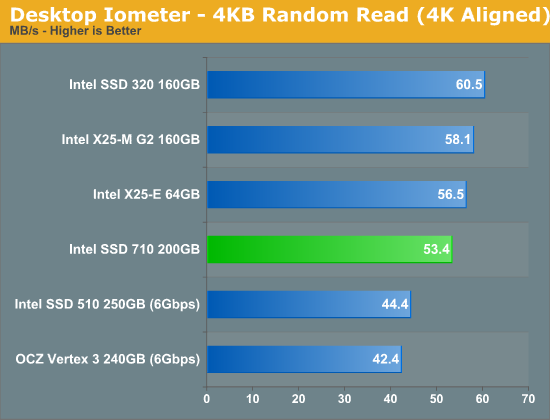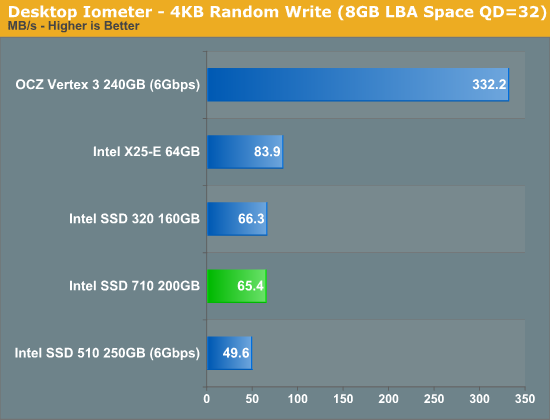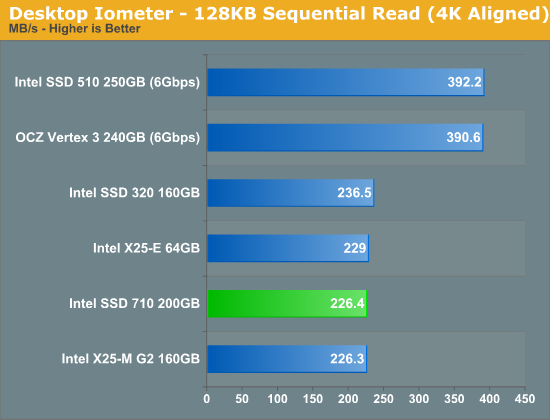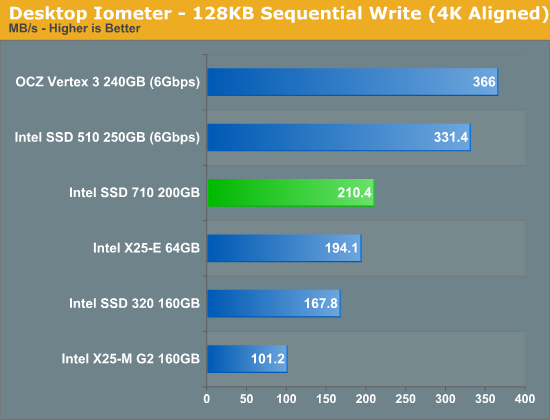The Intel SSD 710 (200GB) Review
by Anand Lal Shimpi on September 30, 2011 8:53 PM EST- Posted in
- Storage
- SSDs
- Intel
- Intel SSD 710
Random Read/Write Speed
The four corners of SSD performance are as follows: random read, random write, sequential read and sequential write speed. Random accesses are generally small in size, while sequential accesses tend to be larger and thus we have the four Iometer tests we use in all of our reviews.
Our first test writes 4KB in a completely random pattern over an 8GB space of the drive to simulate the sort of random access that you'd see on an OS drive (even this is more stressful than a normal desktop user would see). I perform three concurrent IOs and run the test for 3 minutes. The results reported are in average MB/s over the entire time. We use both standard pseudo randomly generated data for each write as well as fully random data to show you both the maximum and minimum performance offered by SandForce based drives in these tests. The average performance of SF drives will likely be somewhere in between the two values for each drive you see in the graphs. For an understanding of why this matters, read our original SandForce article.

Random read performance is actually a bit behind the SSD 320 and old X25-M G2, but still within the same ballpark and comparable to the X25-E. Note that random read performance has always been a strong suite of Intel's, which is very important to many database workloads.

Random write performance is in the same ballpark as the other Intel MLC SSDs, however the X25-E is noticeably faster. SLC NAND is always easier to write to, and we see that advantage clearly here. Although the 710 does ok here, newer controllers from SandForce have raised the bar for highly compressible random write performance by a significant margin.

At high queue depths the X25-E is still significantly faster. Given the random nature of many enterprise server workloads, the 710 could end up slower than the X25-E.
Sequential Read/Write Speed
To measure sequential performance I ran a 1 minute long 128KB sequential test over the entire span of the drive at a queue depth of 1. The results reported are in average MB/s over the entire test length. These results are going to be the best indicator of large file copy performance.

Sequential speed is also quite similar to other Intel drives. Note the slight drop in performance compared to the SSD 320. With the type of workloads the 710 is aimed at, I don't expect large file sequential performance to be a limiting factor. Once again we see that newer 6Gbps controllers from Marvell and SandForce offer much better performance here.

Sequential write performance is up quite a bit over the previous generation drives. The additional spare area is part of the story here, though the 6Gbps controllers still maintain their lead.










68 Comments
View All Comments
AnnonymousCoward - Sunday, October 2, 2011 - link
Use a CD; that's mechanical storage.Flash is definitely a poor choice, since charge is slowly lost. I'm not sure about magnetic hard drives.
ggathagan - Monday, October 3, 2011 - link
If you use optical media, better have it a manufactured ROM disk, as opposed to writable media.Even the best consumer optical media is only good for around 10 years.
James5mith - Monday, October 3, 2011 - link
One thing intel and the rest of the SSD crowd by far have failed to address is the limitations of SATA for enterprise workloads. Doesn't matter how fast your drive is, on a SATA interface it will tank in truly heavy mixed I/O environments. Native SAS SSD's are needed to move the hdd form factor SSD's forward in the industry.That being said, in my research for an in-house project, I discovered Smart Modular. Their Optimus SAS SSD's are up to 1.6TB/drive, and at that capacity are still below $3/GB.
To be fair, I have not gotten any of them in house to test yet, so I can't say how well they will do. But knowing the difference moving from SATA to SAS drives make in an array, I would have to imagine it will be significant when I do.
Not to mention, from a pure density standpoint, 1.6TB 2.5" SSDs can pack more density per rack unit than 3TB 3.5" drives. Once you get to the 4TB 3.5" drives, the crown returns to slow spinning media though.
jhh - Monday, October 3, 2011 - link
A conventional HDD wouldn't fare much better. The typical service life of an enterprise HDD is 5 years after a storage period of no more than 6 months. Beyond that point, the MTBF numbers aren't valid. That doesn't mean the drive will immediately fail. But, conventional HDDs aren't meant to be stored for a long period of time. The lubricating medium (grease or oil) will start moving away from where it is supposed to be, so that parts which were supposed to be lubricated won't be lubricated. The lubricant may also start oxidizing, becoming less of a lubricant. I'm not sure that a drive sitting around for 5 years will be any worse than a drive which was operating for 5 years, but I wouldn't count on either to be around for 20 years, let alone 50.If you want to be sure those baby pictures will still be around to show their grandkids, best to print the pictures, as we have never developed a better archival storage device. Better yet, paint it in some obscure cave in France. If you want the time capsule information to be available, print it on archival paper with archival inks.
rikmorgan - Tuesday, October 11, 2011 - link
I see an article in EE Times saying Samsung is producing flash NAND on their new 20nm FAB now and expects to begin running it at 10nm next year. Just passing it on, don't know how newsworthy it is. ET Times 10/10/2011 edition.Linkpl4y - Saturday, October 15, 2011 - link
Well you've made it this far. Hopefully you've learned something on the way.Here's the next path on your journey. http://bit.ly/nqPUwd
Iketh - Monday, October 17, 2011 - link
LOLmayaw - Saturday, November 5, 2011 - link
Because I do video graphics and its really the only thing that slows my system down for any type of reference # on tests. Even with a 10,000 RPM drive I have 12gb of mem and I upgrade my processor every 3-4 years when I can but I really never think of the hard drive. But now I am seriously thinking about getting one of these.Oh and by the way guys I think that the collar of his shirt is stretched out because his head is so big and it has to stretch itself out cause of the big brain he has in it unlike ppl who are arguing about someone that is wearing a t-shirt on a hard drive review.